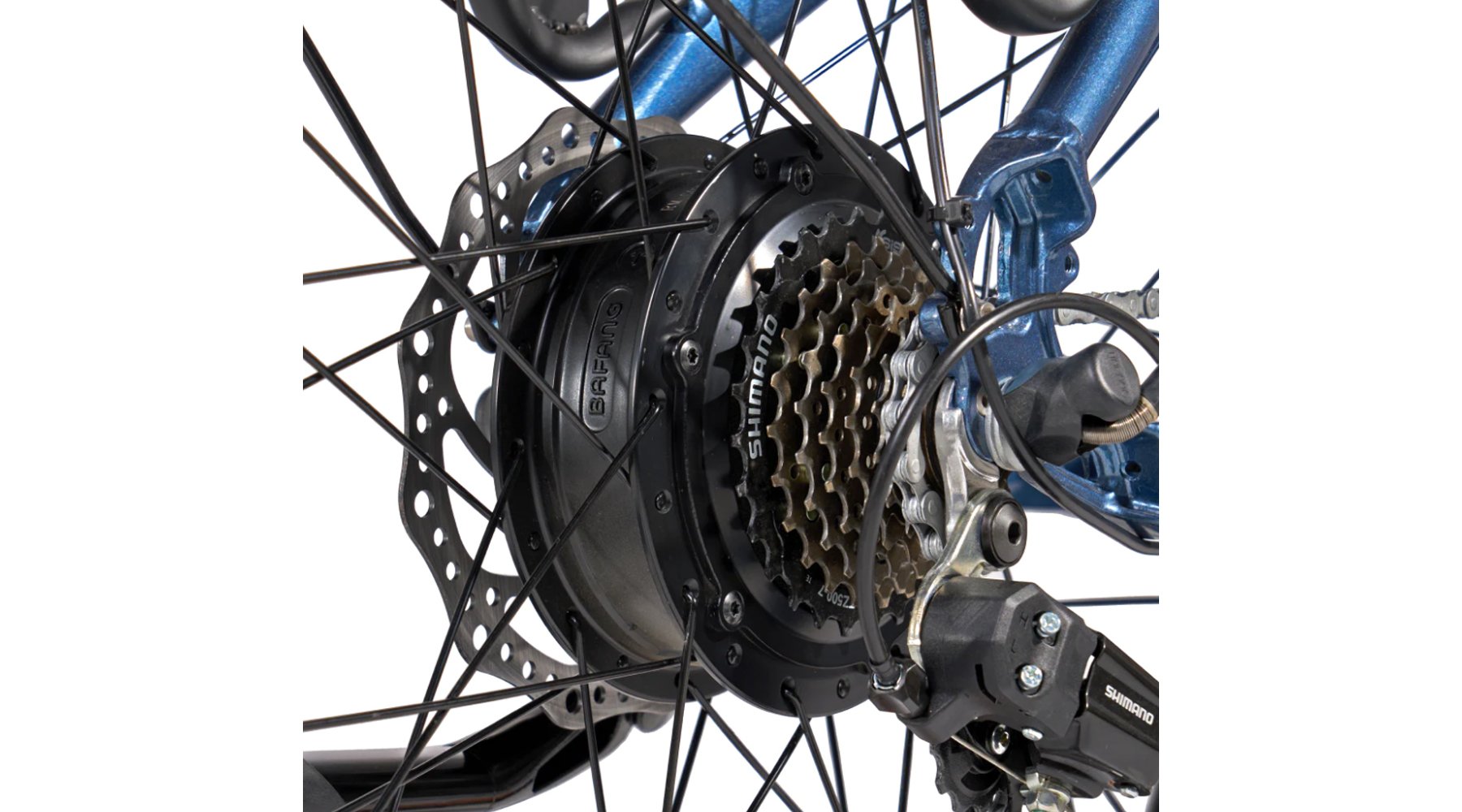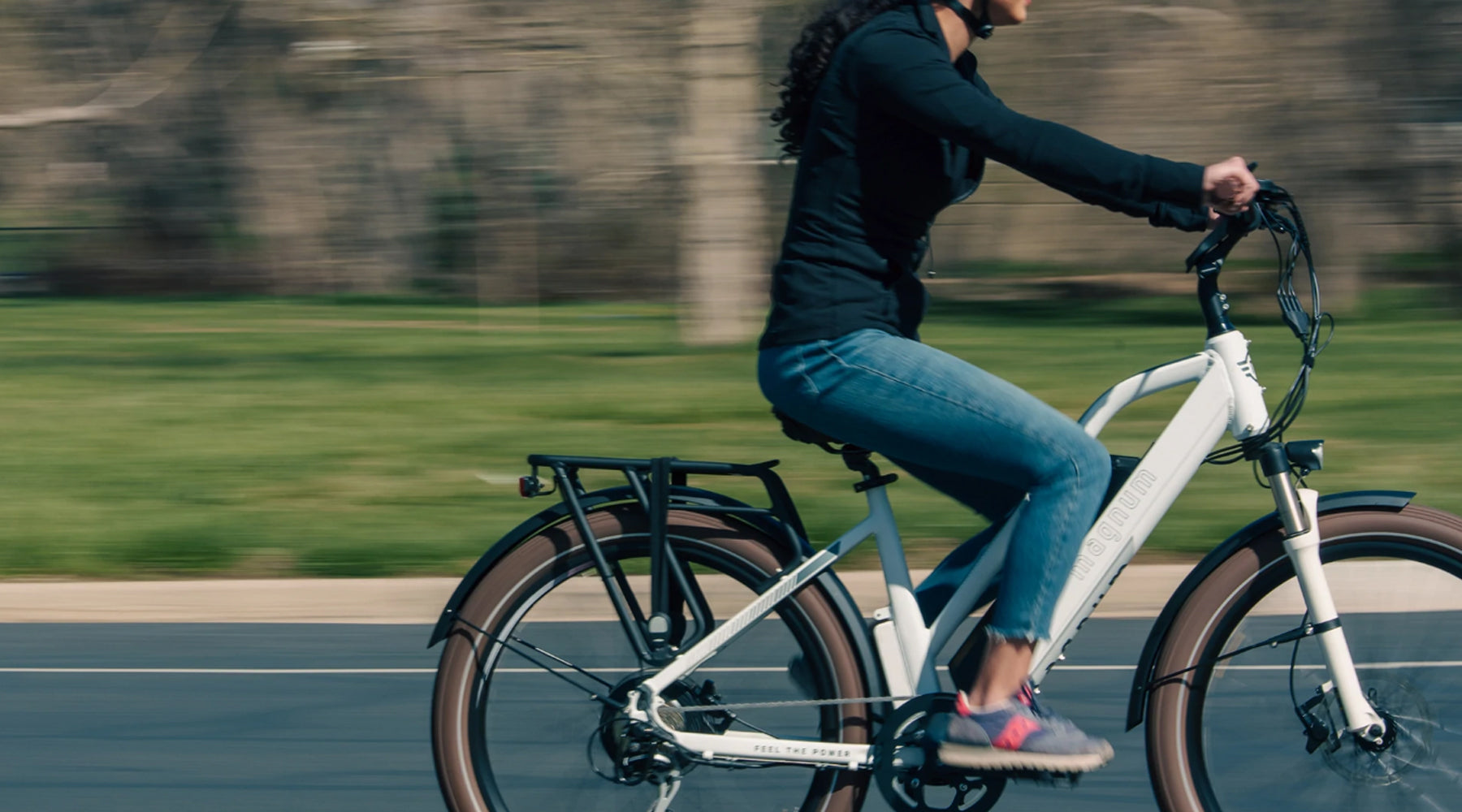How Do E-Bike Motors Work?
What powers an electric bike motor, and how does that power translate to speed? What types of motors are there? Why are there different placements for motors on different e-bikes — on the wheels or by the pedals?
Here’s what you need to know about how e-bike motors work.
Looking for something in particular? Jump ahead to the section you want to check out:
How Does The Motor Work On An E-Bike?
Hub Motors vs. Mid-Drive Motors For Electric Bikes
E-Bike Motor Placement: Rear, Mid-Drive, Or Front
How Does The Motor Work On An E-Bike?
The motor is an important part of your e-bike’s electrical system — but it doesn’t work alone!
When you engage your e-bike’s throttle — or pedal with your pedal assist system activated — those components first send a signal to your e-bike’s controller.
Wait — what’s a controller?
How The Battery And Controller Power Your Motor
Think of the controller like your e-bike’s brain: it receives instructions from the rider via the display or throttle, figures out what needs to be done, and sends commands to the battery and motor to carry out those instructions.
When the controller signals the battery, the battery sends an appropriate amount of power to the motor.
That amount is determined by the amount the rider engages the throttle, the speed at which they’re pedaling, and/or the level of pedal assistance they’ve selected.
Additionally, for e-bikes with a torque sensor, the amount of force with which the rider pedals also helps regulate the amount of power sent to the motor!
Hub Motors vs. Mid-Drive Motors For Electric Bikes
There are 3 main types of motors available for electric bikes. Two of them fall into the category of “hub motors” while the other — “mid-drive” — stands alone. Let’s take a look at each type.
Geared Hub Motors
Based on the name, you might think that geared hub motors leverage the mechanical gears on your bike for power — but that’s actually not the case!
The hub is a cylindrical case located on an e-bike’s wheel (usually the rear wheel), and the “geared” part refers to a set of gears within the hub. These gears regulate the speed at which the motor turns, which ensures that the motor delivers the correct amount of torque needed to power your e-bike. That amount of power can be anything from just a little boost up to your e-bike’s maximum assisted speed.
Geared hub motors are usually found on Class 1 and Class 2 e-bikes, which cap out at 20mph with motor assistance. That’s because these motors are well suited to provide lots of torque (force), but aren’t as impressive at the Class 3 e-bike’s faster speeds of up to 28mph.
Geared hub motors are an excellent choice for:
- Riders concerned with e-bike weight (these motors are very light)
- Riders who like to switch between pedal assist and “analog” riding (geared hub e-bikes feature freewheels that make pedaling easier)
- Powerful high-torque riding, such as going up steep hills and/or carrying heavy loads
Just note that, like your e-bike’s mechanical gears, the gears inside a hub motor do require maintenance and eventual replacement. This can happen more quickly if you engage in high-torque rides often.
Direct-Drive Hub Motors
Direct-drive hub motors do not feature any gears within the hub. Instead, the hub itself is the motor that turns the wheel using electromagnetic force.
One half of the hub contains magnets; the other contains wires that transmit power from the battery. The electric current coming through the wires activates movement thanks to the magnets, causing the hub to turn.
They’re a great choice for…
- Riders bothered by noisy e-bikes (direct drive motors are virtually silent)
- Riders who use pedal assist and/or throttle regularly (there’s no freewheel, which makes pedaling a bit more difficult when the motor isn’t engaged)
- High-speed rides, especially Class 3 e-bikes that provide motor assistance up to 28mph
Be aware that direct-drive hub motors are heavier than geared hub motors, which adds some weight to your bike. They’re also less energy-efficient overall.
Mid-Drive Motors
Mid-drive motors are the only e-bike motor style that doesn’t feature a hub.
Instead, the motor is integrated into the pedals and crankset. It turns the chain, rather than the wheel.
Like a geared-hub motor, the mid-drive motor regulates the speed at which the motor turns. The difference is that a mid-drive motor uses the e-bike’s mechanical gears to do so, whereas a geared hub motor uses a unique set of gears integrated into the hub itself, separate from the e-bike’s mechanical gears.
It’s said that out of all motor types, e-bikes with mid-drive motors offer the best balance. That’s due to the fact that a motor is among the heavier components of an e-bike, which means that placing it on the front or rear of the bike can shift the bike’s center of gravity forward or back.
Instead, the mid-drive motor’s low central location between the pedals of a bike offers better balance and a feel more akin to riding a traditional bike.
Mid-drive motors are ideal for…
- Riders who want the most traditional bike feel while riding
- Riders who don’t mind higher cost (e-bikes with mid-drive motors tend to be the most expensive to manufacture, resulting in a higher price)
- Ease of changing tires or wheels (since the motor isn’t integrated into either wheel, removing wheels and tires on a mid-drive e-bike is easier vs. hub motors)
Most Magnum Bikes feature either geared-hub or direct-drive hub motors. But in 2023, Magnum launched its first models with mid-drive motors
Our mid-drive models stand out from the pack in a few key ways:
They feature both pedal-assist systems and throttles — throttles aren’t often seen on e-bikes with mid-drive motors
They are truly high-torque motors — while other e-bikes claim high levels of torque at 90Nm (Newton-meters), ours give a whopping 130Nm of torque!
About half of our models feature direct-drive hub motors, including:
- Cosmo S, Cosmo X, Cosmo+
- Cruiser 2.0
- Low Rider 2.0
- Metro 750, Metro S
- Nomad
- Pathfinder 500, Pathfinder T
- Payload
- Peak Series
- Ranger 1.0, Ranger 2.0
- Scout
- Voyager
The rest are geared hub motors, including:
- Cosmo
- Cruiser 1.0
- Low Rider 1.0
- Metro X
- Navigator Series
- Pathfinder 350
- Premium 3 High Step, Premium 3 Low Step
- Summit 27.5”, Summit 29”
E-Bike Motor Placement: Rear, Mid-Drive, Or Front
There are 3 different placements for the motor on an e-bike, and each comes with unique features.
Front-Motor Electric Bikes
Front-motor e-bikes are located on the front wheel and are always direct-drive motors. Their placement on the front wheel means the motor turns the wheel itself. They’re also usually lower in wattage than mid-drive or rear motors — typically 350W or below.
Mid-Drive Motor Electric Bikes
Mid-drive motors are integrated into the e-bike’s crankset. Mid motors are typically direct-drive and power the crankset instead of the wheel.
A unique feature of mid-drive motors is that the motor and battery are placed right next to each other. This proximity translates all power coming from the battery directly to the motor with virtually no loss of power through the electrical system.
Rear-Motor Electric Bikes
Rear-motor hub e-bikes may be either geared or direct-drive. While servicing rear motors can be a bit complex due to their integration with the rear wheel, brakes, etc., they provide excellent power with higher wattage levels compared to front-motor and some mid-motor bikes.
Rear-motor placement also makes e-bikes appear the most similar to traditional bikes, though battery placement also influences this.
When it comes to our geared hub and direct-drive motors, Magnum exclusively offers rear-wheel hub placement. But we’ve also introduced 2 powerful mid-drive motors to our line-up, prioritizing power and balance.
 A Bafang rear-mounted gear hub motor on our Magnum Cosmo.
A Bafang rear-mounted gear hub motor on our Magnum Cosmo.
What About Motor Wattage?
Wattage plays a big role in your motor’s characteristics and performance — too big of a role to fit here! So check out our post, E-Bike Motors: 350W vs. 500W vs. 750W, to learn more about the role wattage plays in your ride.
If you have any more questions about your e-bike motor, we’re here for you! Check out our support articles on Motor Mechanics or contact our support team.


